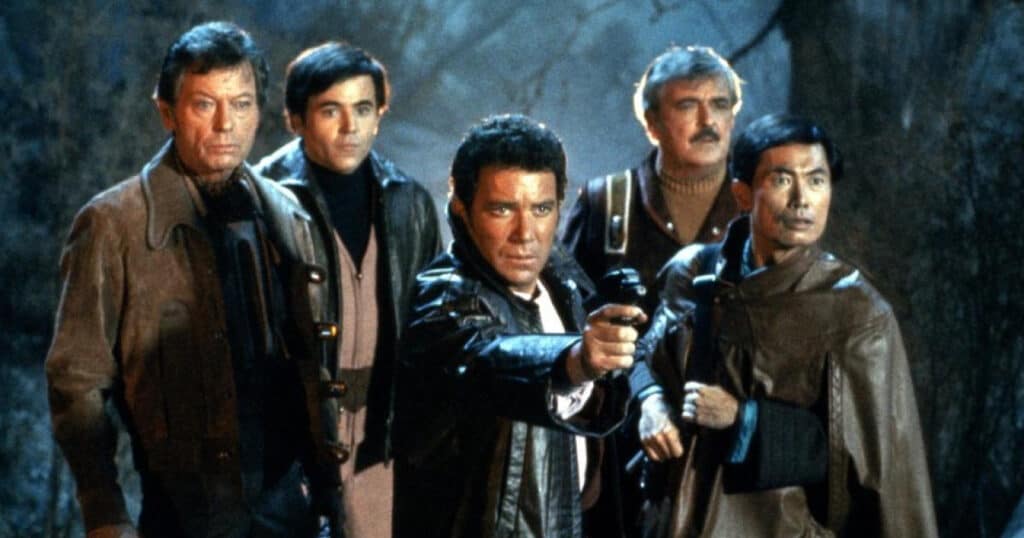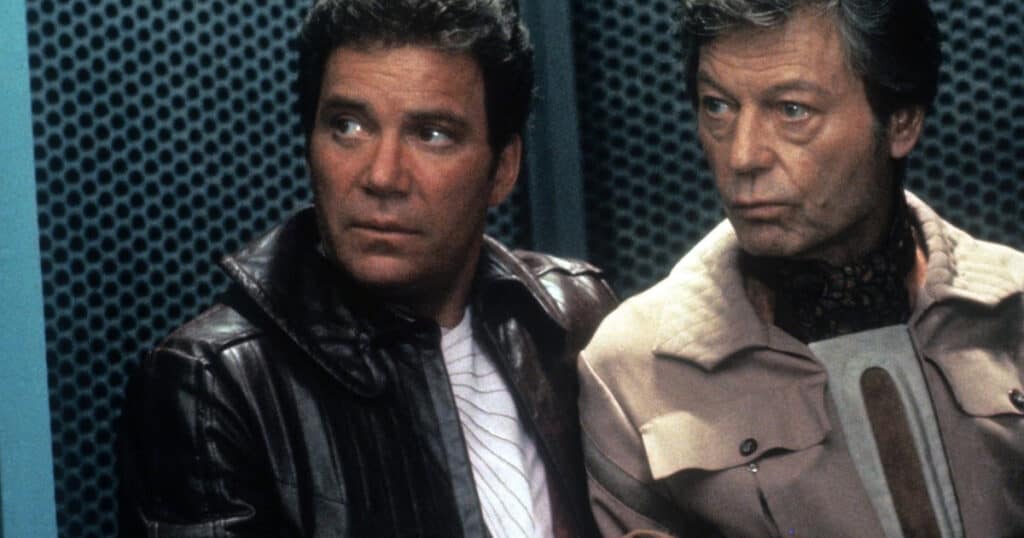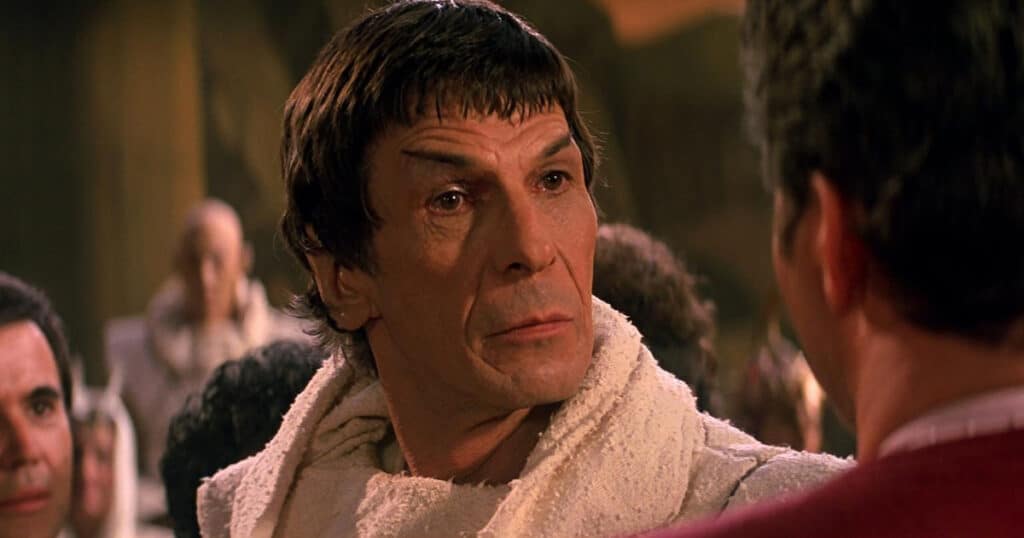
In 1982, Paramount Pictures released Star Trek II: The Wrath of Khan. Despite carrying a considerably lower budget than its predecessor, the film was a smash hit at the box office, grossing $78 million, good enough to make it the sixth highest-grossing movie of the year. A sequel, at this point, was a given, but the question remained, would Mr. Spock be involved? After all, Leonard Nimoy had been outspoken for years about wanting to move away from the role, even writing a memoir called “I’m Not Spock.” He was killed off in Star Trek II, but a last-minute insert showing him doing a mind-meld with Dr. McCoy teased that perhaps Spock wasn’t quite as dead as he seemed. Indeed, Star Trek III: The Search for Spock would hit theatres in 1984 and be directed by Nimoy, with the film launching a successful career behind the camera for the actor. How did it all happen?
Shortly after Star Trek II came out, Nimoy was approached by Paramount Pictures about being in a potential third film, and he said yes, on the condition that he be allowed to direct. While this may seem like an outrageous request, Nimoy had directed plenty of T.V., including two episodes of William Shatner’s T.J. Hooker, including a well-received instalment he starred in, Vengeance is Mine that featured him as a father hellbent on murdering his daughter’s rapist. Everyone, including Shatner, was aboard with Nimoy behind the camera, except perhaps the one person who really mattered, studio head Michael Eisner, who believed Nimoy hated Star Trek and had demanded to be killed off. Nimoy had to convince him that this wasn’t the case and that he was committed to the franchise going forward before getting the opportunity to direct.
Perhaps conscious that the last film had only really been a smash in North America, the budget was kept relatively low, costing $16 million compared to the previous movie’s $12 million. The F.X. were considerably better for a myriad of reasons. Still, the most important was that they were able to re-used sets and uniforms from Wrath of Khan, allowing ILM to create some truly memorable sequences, such as the climactic explosion of the U.S.S. Enterprise.
Ultimately, writer-producer Harve Bennett used a relatively simple device to bring Spock back. We learn that Spock transferred his essence, his Katra, to McCoy. His body is still on the new planet, Genesis, so Kirk, McCoy, Sulu, Scotty and Chekov, with an assist from Uhura and forced to hijack the Enterprise to return to the now forbidden planet. Meanwhile, Kirk’s son David Marcus, along with the last film’s breakout character Saavik, who was recast after the late Kirstie Alley bailed, are sent to Genesis themselves to investigate a mysterious lifeform that they discover is actually Spock. The Genesis Effect has rejuvenated his body, but the planet is dangerously unstable due to David’s shortcuts, and Spock’s body ages from being a baby to adulthood in days. Meanwhile, a rogue Klingon commander, Kruge, discovers and wants the Genesis secret for the Klingon Empire. All three groups collide for a showdown on Genesis, which will forever change the franchise’s greatest hero, James T. Kirk.
Here’s the thing – Star Trek III: The Search for Spock is the second instalment of a loose trilogy made up of the second, third and fourth films, with the sixth serving as a kind of epilogue. You could call it the Genesis Trilogy, but I tend to view it as The Kirk Saga, as his film arc gives the franchise one of its core throughlines. In Star Trek II, Kirk is in a mid-life crisis, and indeed by the time the film ends, he’s lost his best friend but gained a son. The third film would reverse that, as he’s able to get his best friend back but loses his son. It changes the formerly kind and heroic Kirk into a much more cynical, bitter captain, something which only really pays off in the sixth film and is all but ignored by the fifth. He hates Klingons. He blames them for the death of his son, and when he learns that the entire race is on the verge of being killed off, his answer is simply, “let them die.” Thus, the third film is important for Shatner, as, for the first time, Kirk loses – and loses big.

Indeed, the movie ends with the destruction of the U.S.S. Enterprise, something which no doubt hit fans hard in 1984, but the fact that Kirk’s rescue of Spock comes at so high a cost makes this perhaps the most underrated, thrilling instalment of the series. Nimoy, despite it being his first go as a feature director, makes a good film. It’s not as well-crafted as the second, but he keeps the pace moving along nicely (it’s the shortest film in the franchise) and shows a flair for directing action. Indeed, the movie has one of Kirk’s most memorable scenes, as at the end of the film, he’s trapped on Genesis with the movie’s villain, Christopher Lloyd’s Kruge and the two go head-to-head in a battle to the death. While people may mock Shatner’s “I have had enough of you” one-liner, as kids, we used to say it over and over because we thought it was cool.
One of the best things about Star Trek III is the cast. Shatner gets to do some of his best acting here, especially when he realizes his son’s been murdered. DeForest Kelly gets his best Trek part to date, with McCoy on the verge of insanity for much of the film, as he can’t handle Spock’s Katra. With Nimoy sidelined, McCoy becomes Kirk’s number 2 and seems to relish the more prominent role. Scotty and Chekov don’t get much to do. Still, Sulu and Uhura both have nice moments, Wirth Sulu using judo on a hurling security guard who makes the mistake of calling him “tiny.” At the same time, Uhura hijacks the transporters for our lovable crew. The best of all is Christopher Lloyd. His casting must have been seen as pretty wild in 1984. He hadn’t played Doc Brown in Back to the Future yet and was primarily known as the permanently stoned Reverend Jim from Taxi. He was so good in the part that one wonders if this helped nab him his role in Back to the Future.

Interestingly, John Larroquette, who everyone will remember as the iconic Dan Fielding on Night Court, plays Kruge’s second in command, Maltz. It’s a small role, but Maltz does come off as somewhat remorseful toward the end. My only issue is that because all of the other Klingons are dead at this point, why weren’t Saavik, Scotty, Chekov and Sulu unable to take over the Klingon Bird of Prey if they only had to deal with Maltz? Does Kirk have to do everything??? The only place where the cast comes up short is Robin Curtis – not that she’s a bad Saavik, but Alley was so iconic in the part one wished she had returned for the sequel.
However, one person that did return was James Horner, who once again composed a superb score, with Nimoy raving about it in the Search for Spock’s special features on the DVD/Blu-ray. In the end, critics politely but unenthusiastically received the film, many of whom compared it unfavourably to The Wrath of Khan. One of the folks who didn’t care for it was President Ronald Reagan, who watched it at Camp David and wrote in his journals that it “wasn’t too good .”Whatever – as a fan, this movie holds a special place in my heart. Is it predictable? Sure, but only in the fact that, because the film is called The Search for Spock, you know they’re not going to end it with them saying, “Sorry, we couldn’t find him .”As a Trekkie, this is probably my third or fourth favorite in the series, and audiences seem to agree with me, with it making only $2 million less than The Wrath of Khan at the domestic box office – $76.5 million, despite competition from Gremlins, Ghostbusters and Indiana Jones and the Temple of Doom. It was a big enough hit that Paramount opted to increase the budget significantly for the next film, which would become one of the few Trek movies ever to make a lot of money overseas, but that’s a story for another time!
Originally published at https://www.joblo.com/star-trek-iii-the-search-for-spock-revisited-the-most-underrated-trek/


